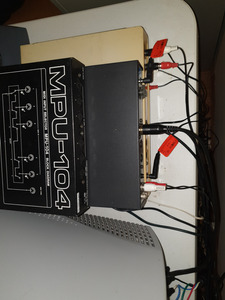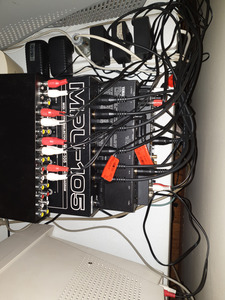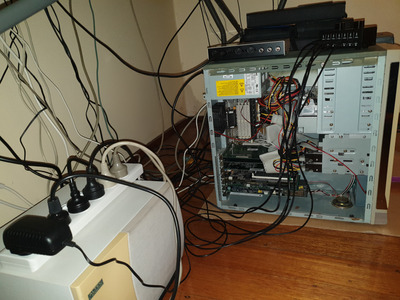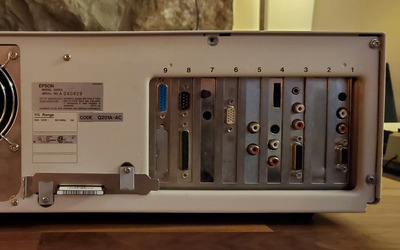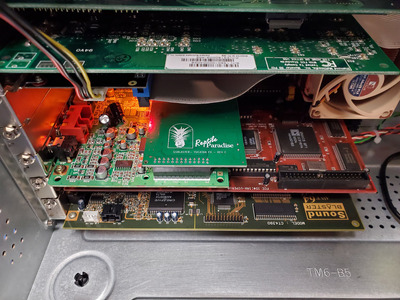First post, by Rincewind42
Here's the deal: I'm super into audio, OPL, MIDI, etc., I have the following ingredients, and I'm intent on doing something cool with them! 😎
Sound cards:
- ESS ES1868F (full PnP)
- Sound Blaster AWE32 CT3900 ("semi-PnP", only base address and MPU-401 must be selected via jumpers)
MIDI & wavetable stuff:
- Roland SC-55
- MP32L (for MT-32 & CM-32L)
- DB15MIDI
- Chil and Phil Adapter
- DreamBlaster S2
- QWave
- McFly
Also, I have a Yamaha MG10XU 10-channel mixer to hook everything up.
This is the plan (for DOS gaming only; I have dedicated Win98 and WinXP boxes):
ESS
- Set to A220 I7 D1 H5 P330 via UNISOUND for the best compatibility with older games in its SB Pro mode under DOS. Also, older games have the MPU port hardcoded to 330.
- Under Win 3.1x the card can do 16-bit digital sound
- QWave on the internal waveblaster header (my #1 favourite waveblaster daughterboard!)
- DB15MIDI in the gameport to drive the external SC-55 and MP32L MIDI modules
AWE32
- Set to A240 I5 D3 H7 P300 E640 (base address 240 and MPU address 300 needs to be configured via jumpers, the rest can be soft-switched)
- Chill and Phil Adapter in the gameport with the DreamBlaster S2 installed
- McFly on the internal waveblaster header (it doesn't work with the Chill and Phil adapter for me, unfortunately)
Then the 10 mixer channels (5 stereo channels) will be assigned as follows. Of course, it's not possible to have something playing on all 10 channels at the same time, but I just want to hook things up once and not have to screw around with cables afterwards...
- 1-2 — ESS line out (ESFM "OPL", digi, QWave)
- 3-4 — SC-55
- 5-6 — MP32L
- 7-8 — AWE32 line out (OPL3, digi, McFly)
- 9-10 — DreamBlaster S2
I think this would work nicely. I definitely prefer the SB Pro style filter of the ESS when using its Sound Blaster emulation mode (in 16-bit operation with WSS, or with games that have specific ESS support it uses the same variable-cutoff brickwall filter as the SB16).
The main point of having the AWE32 is for games that have direct support for it. I'm really fond of the sound of these small wavetable ROM sets, QWave, AWE32, etc. I actually prefer them to the DreamBlaster S2 most of the time... but of course that little board is cool too, just different 😄
I really like how the ESFM sounds, but my slight disappointment with this solution is that I wouldn't be able to utilise the true OPL3 chip of the AWE32 in older games, then in newer games I'd use MIDI or direct AWE32 support anyway. The other cool thing is that I could add reverb & chorus to the OPL output of the AWE32 (but then, this is a digital mixer so I can add much higher quality reverb to any channel easily, and in fact I do that to the ESFM output, and I even add some reverb to the QWave to give it some space).
Hmm, I guess I could use batch files and configure either the ESS or the AWE32 to IRQ 7 and DMA 1, depending on the game, and the other card just to some other random settings to avoid conflicts.
What would be best is to combine the SB Pro emulation of the ESS for digital sound with the (to my ears) superior SB Pro filters, and the OPL3 on the AWE32 with EMU8k reverb. Well, I can actually do that in games that have more advanced setup programs (e.g. newer Miles Sound System), but not all of them are like that, especially not the older ones where I would like to pick the OPL music option...
More ideas:
- I have ordered the SPDIF breakout thing for the AWE, so I'll be able to use a TOSLINK->analog audio converter box to hook it up to the mixer. Although my AWE is not noisy (yes, there is some audible hiss but at a rather low volume, so it doesn't bother me one bit on my quite good studio headphones).
- Install DIP switches to be able to reconfigure the AWE32 to base address 220 without opening the case 😎 🤘
Anyway, interested to hear what you guys think, your experiences with similar setups, and what ideas you might have! 😄
DOS: Soyo SY-5TF, MMX 200, 128MB, S3 Virge DX, ESS 1868F, AWE32, QWave, S2, McFly, SC-55, MU80, MP32L
Win98: Gigabyte K8VM800M, Athlon64 3200+, 512MB, Matrox G400, SB Live
WinXP: Gigabyte P31-DS3L, C2D 2.33 GHz, 2GB, GT 430, Audigy 4
